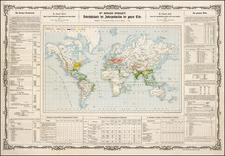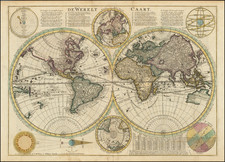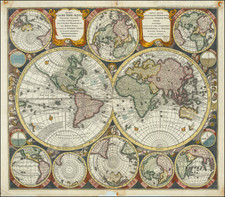Cannibalism and Conversos: ". . . For young people in particular it will be found highly instructing and entertaining. " (Leigh's).
Large separately published chart of the world, focusing on the Religion, Population and Civilization of each Country, published by James Wyld in London in 1818.
The map provides sweeping image of the world, subdivided into ethnic regions, colored by "The Principal Regions, with the presumed number of their Followers."
West of the Coast of Spain, a note appears:
There are among the Spaniards and Portuguese a number of Moors and converted Jews (at least in appearance).
Below the Aleutian Islands, the following note appears:
Among many American tribes their are neither temples no idol nor any external form of worship, Some worship the sun as a principal divinity, and some honour the moon under the title of mother. To evil deities they present offerings, and sometimes sacrifice slaves and prisoners, to avert their displeasure.
The map also includes numerous smaller notes around the map, including the following note north of Hawaii:
It is probable, that this babarous (sic) custom of offering human victims, prevails in all, or most of the Islands in the Pacific Ocean.
In the South Pacific, east of New Zealand, the following note appears:
It is highly probable, that the practice of feeding on the bodies of enemies was originally prevalent in all the Islands of the Pacific Ocean, through it is not known, by positive and decisive evidence, to exist in any of them, except New Zealand.
To the west of South Africa, the following note appears:
The chief worship of the Jagas consists in frequent sacrafices of human victims, particularly children.
To the east of Labrador, the following note appears:
Esquimaux or Iskimo, is said to imply an easter of raw flesh.
The following quote appears describing the map in Leigh's New Picture of London; or, A view of the Poltical, Religious Medical, Literary, Municipal, Commercial and Moral State of the British Metropolis:
This valuable Chart well deserves a place in every library; for young people in particular it will be found highly instructing and entertaining.
Rarity
The map is quite rare. This would appear to be the second state of the map, first published in 1815, with a third state issued in 1820.
We locate 1 example of the 1815 and 1 example of the 1820 in OCLC (British Library). No examples of the 1818 map were located.
James Wyld Sr. (1790-1836) was a British cartographer and one of Europe’s leading mapmakers. He made many contributions to cartography, including the introduction of lithography into map printing in 1812.
William Faden, another celebrated cartographer, passed down his mapmaking business to Wyld in 1823. The quality and quantity of Faden’s maps, combined with Wyld’s considerable skill, brought Wyld great prestige.
Wyld was named geographer to Kings George IV and William IV, as well as HRH the Duke of York. In 1825, he was elected an Associate of the Institution of Civil Engineers. He was one of the founding members of the Royal Geographical Society in 1830. Also in 1830, his son, James Wyld Jr., took over his publishing house. Wyld Sr. died of overwork on October 14, 1836.
James Wyld Jr. (1812-87) was a renowned cartographer in his own right and he successfully carried on his father’s business. He gained the title of Geographer to the Queen and H.R.H. Prince Albert. Punch (1850) described him in humorous cartographic terms, “If Mr. Wyld’s brain should be ever discovered (we will be bound he has a Map of it inside his hat), we should like to have a peep at it, for we have a suspicion that the two hemispheres must be printed, varnished, and glazed, exactly like a pair of globes.”











![Карта Часовыхъ Поясовъ. [Map of Time Zones]](https://storage.googleapis.com/raremaps/img/small/95040.jpg)



![Earth Atlantic View [Waterman Projection]](https://storage.googleapis.com/raremaps/img/small/86011.jpg)
